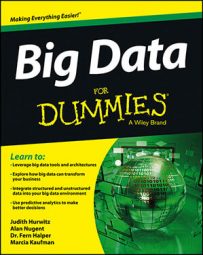Data mining involves exploring and analyzing large amounts of data to find patterns for big data. The techniques came out of the fields of statistics and artificial intelligence (AI), with a bit of database management thrown into the mix.
Generally, the goal of the data mining is either classification or prediction. In classification, the idea is to sort data into groups. For example, a marketer might be interested in the characteristics of those who responded versus who didn’t respond to a promotion.
These are two classes. In prediction, the idea is to predict the value of a continuous variable. For example, a marketer might be interested in predicting those who will respond to a promotion.
Typical algorithms used in data mining include the following:
Classification trees: A popular data-mining technique that is used to classify a dependent categorical variable based on measurements of one or more predictor variables. The result is a tree with nodes and links between the nodes that can be read to form if-then rules.
Logistic regression: A statistical technique that is a variant of standard regression but extends the concept to deal with classification. It produces a formula that predicts the probability of the occurrence as a function of the independent variables.
Neural networks: A software algorithm that is modeled after the parallel architecture of animal brains. The network consists of input nodes, hidden layers, and output nodes. Each unit is assigned a weight. Data is given to the input node, and by a system of trial and error, the algorithm adjusts the weights until it meets a certain stopping criteria. Some people have likened this to a black–box approach.
Clustering techniques like K-nearest neighbors: A technique that identifies groups of similar records. The K-nearest neighbor technique calculates the distances between the record and points in the historical (training) data. It then assigns this record to the class of its nearest neighbor in a data set.
Here's a classification tree example. Consider the situation where a telephone company wants to determine which residential customers are likely to disconnect their service.
The telephone company has information consisting of the following attributes: how long the person has had the service, how much he spends on the service, whether the service has been problematic, whether he has the best calling plan he needs, where he lives, how old he is, whether he has other services bundled together, competitive information concerning other carriers plans, and whether he still has the service.
Of course, you can find many more attributes than this. The last attribute is the outcome variable; this is what the software will use to classify the customers into one of the two groups — perhaps called stayers and flight risks.
The data set is broken into training data and a test data set. The training data consists of observations (called attributes) and an outcome variable (binary in the case of a classification model) — in this case, the stayers or the flight risks.
The algorithm is run over the training data and comes up with a tree that can be read like a series of rules. For example, if the customers have been with the company for more than ten years and they are over 55 years old, they are likely to remain as loyal customers.
These rules are then run over the test data set to determine how good this model is on “new data.” Accuracy measures are provided for the model. For example, a popular technique is the confusion matrix. This matrix is a table that provides information about how many cases were correctly versus incorrectly classified.
If the model looks good, it can be deployed on other data, as it is available (that is, using it to predict new cases of flight risk). Based on the model, the company might decide, for example, to send out special offers to those customers whom it thinks are flight risks.

